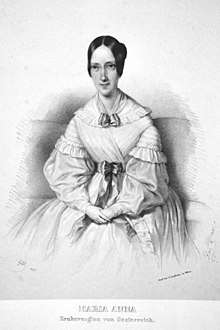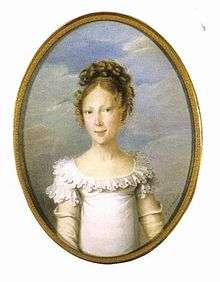Archduchess Marie Anne of Austria
Marie Anne of Austria (Maria Anna Franziska Theresia Josepha Medarde; 8 June 1804 – 28 December 1858) was an Archduchess of Austria and the daughter of Franz II, Holy Roman Emperor and his second wife, Maria Theresa of Naples and Sicily.
| Marie Anne of Austria | |||||
|---|---|---|---|---|---|
 | |||||
| Born | 8 June 1804 Hofburg Palace, Vienna | ||||
| Died | 28 December 1858 (aged 54) Hetzendorf Palace, Vienna, Austria | ||||
| Burial | |||||
| |||||
| House | Habsburg-Lorraine | ||||
| Father | Francis II, Holy Roman Emperor | ||||
| Mother | Maria Theresa of Naples and Sicily | ||||
| Religion | Roman Catholic | ||||
Biography

Marie Anne was born 8 June 1804 at the Hofburg Imperial Palace in Vienna. She was the tenth child born to her parents. Her mother, Maria Theresa, died after giving birth to her only younger sister Archduchess Amalie Theresa who died with their mother in 1807.
She is said to have been intellectually disabled (like her eldest brother, Emperor Ferdinand I) and to have suffered from a severe facial deformity.[1]
After living in Schönbrunn Palace, she was moved in 1835 to Hetzendorf Palace,[2] where she spent the rest of her life, and where she died on 28 December 1858.[3]
Marie Anne was buried at the Capuchin Church in Vienna, more specifically in the Imperial Crypt, the burial place of her siblings Marie Louise, Duchess of Parma, Ferdinand I of Austria, Archduchess Marie Caroline, Archduchess Caroline Ludovika of Austria, Archduke Johann Nepomuk of Austria, Archduchess Amalie Theresa of Austria, and Archduke Franz Karl of Austria. Her parents, Francis II, Holy Roman Emperor and Maria Theresa of Naples and Sicily, and her great-grandmother, Maria Theresa of Austria, are also buried there.
Ancestry
| Ancestors of Archduchess Marie Anne of Austria | |||||||||||||||||||||||||||||||||||||||||||||||||||||||||||||||||||||||||||||||||||||||||||||||||||||||||||||||||||||||||||||||||||||||||||||||||||||||||||||||||||||||||||||||||||||||||||||||||||||||||||||||||||||||||||||||||||||||||||||||||||||||||||||||||||||||||||||||||||||||||
|---|---|---|---|---|---|---|---|---|---|---|---|---|---|---|---|---|---|---|---|---|---|---|---|---|---|---|---|---|---|---|---|---|---|---|---|---|---|---|---|---|---|---|---|---|---|---|---|---|---|---|---|---|---|---|---|---|---|---|---|---|---|---|---|---|---|---|---|---|---|---|---|---|---|---|---|---|---|---|---|---|---|---|---|---|---|---|---|---|---|---|---|---|---|---|---|---|---|---|---|---|---|---|---|---|---|---|---|---|---|---|---|---|---|---|---|---|---|---|---|---|---|---|---|---|---|---|---|---|---|---|---|---|---|---|---|---|---|---|---|---|---|---|---|---|---|---|---|---|---|---|---|---|---|---|---|---|---|---|---|---|---|---|---|---|---|---|---|---|---|---|---|---|---|---|---|---|---|---|---|---|---|---|---|---|---|---|---|---|---|---|---|---|---|---|---|---|---|---|---|---|---|---|---|---|---|---|---|---|---|---|---|---|---|---|---|---|---|---|---|---|---|---|---|---|---|---|---|---|---|---|---|---|---|---|---|---|---|---|---|---|---|---|---|---|---|---|---|---|---|---|---|---|---|---|---|---|---|---|---|---|---|---|---|---|---|---|---|---|---|---|---|---|---|---|---|---|---|---|---|---|---|
| |||||||||||||||||||||||||||||||||||||||||||||||||||||||||||||||||||||||||||||||||||||||||||||||||||||||||||||||||||||||||||||||||||||||||||||||||||||||||||||||||||||||||||||||||||||||||||||||||||||||||||||||||||||||||||||||||||||||||||||||||||||||||||||||||||||||||||||||||||||||||
References
- Palmer, Alan (1997). Twilight of the Habsburgs. Atlantic Monthly Press. p. 4. ISBN 978-0871136657.
- Ottillinger, Eva (1997). Kaiserliche Interieurs: die Wohnkultur des Wiener Hofes im 19. Jahrhundert und die Wiener Kunstgewerbereform. Böhlau. p. 219. ISBN 3205986806.
- Hawlik-Van de Water, Magdalena (1996). Das kaiserliche Lustchloss Hetzendorf : die Modeschule der Stadt Wien. Böhlau. p. 61. ISBN 3205986016.
- Wurzbach, Constantin, von, ed. (1861). . Biographisches Lexikon des Kaiserthums Oesterreich [Biographical Encyclopedia of the Austrian Empire] (in German). 7. p. 60 – via Wikisource.
- Wurzbach, Constantin, von, ed. (1860). . Biographisches Lexikon des Kaiserthums Oesterreich [Biographical Encyclopedia of the Austrian Empire] (in German). 6. p. 208 – via Wikisource.
- Wurzbach, Constantin, von, ed. (1861). . Biographisches Lexikon des Kaiserthums Oesterreich [Biographical Encyclopedia of the Austrian Empire] (in German). 7. p. 53 – via Wikisource.
- Genealogie ascendante jusqu'au quatrieme degre inclusivement de tous les Rois et Princes de maisons souveraines de l'Europe actuellement vivans [Genealogy up to the fourth degree inclusive of all the Kings and Princes of sovereign houses of Europe currently living] (in French). Bourdeaux: Frederic Guillaume Birnstiel. 1768. p. 9.
- Wurzbach, Constantin, von, ed. (1861). . Biographisches Lexikon des Kaiserthums Oesterreich [Biographical Encyclopedia of the Austrian Empire] (in German). 7. p. 81 – via Wikisource.